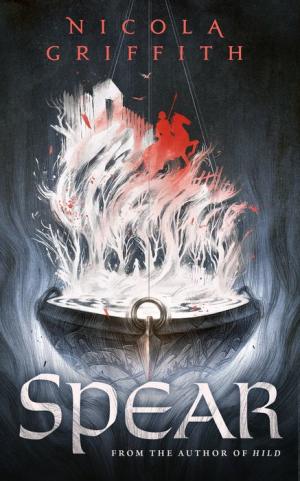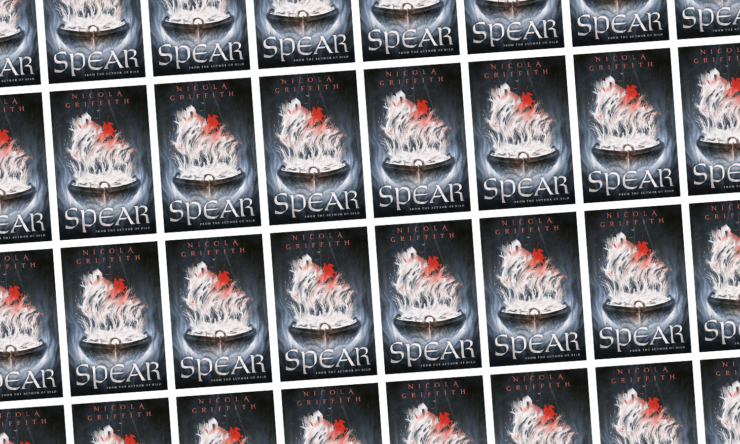If revisionist takes on all things Arthurian are your cup of tea—or, perhaps, your cup of mead—it’s likely been a good couple of years for you. Lavie Tidhar’s novel By Force Alone comes to mind as one recent work that took an intriguing approach to a familiar story; Kieron Gillen and Dan Mora’s comic Once and Future blends a deconstruction of myths with intense action sequences.
There’s also Sword Stone Table, an anthology of Arthurian retellings edited by Jenn Northington and Swapna Krishna—which, it turns out, is part of the origin story for Nicola Griffith’s new novella Spear.
In 2014, I interviewed Griffith about the process of writing her novel Hild. It was in that conversation that she brought up her approach to worldbuilding. “I started off as a science-fiction writer, so that’s my meat and drink—take three facts and build a world from it,” she said. “It’s a joy to me.” In the case of Spear, she had been asked to contribute to Sword Stone Table but soon realized that what was intended to be a short story turned out to be much longer. In this case, though, it’s made for a stronger work—Spear is a fully immersive work of fiction, and one that suggests even more layers of history in its 192 pages.
Buy the Book


Spear
Spear begins with a girl living in isolation in a cave with her mother, Elen. She’s unaware of her true name, and her mother is especially cagey about this matter—and about certain elements of her past. There’s a dizzying amount of information imparted here, dizzying in part because we’re getting it through the perceptions of a child. To wit: “She would shout at the girl and rant, confusing her, confusing the tales, for now Elen herself was in them.” These tales—of the theft of a bowl, of Elen’s connections to the Tuath Dé, and of the girl’s own origins—blur in and out of one another.
One of the intriguing things that Griffith does here is to neatly illustrate the point in childhood where the world as you’ve been told it is and the world as it actually is overlap, sometimes to dissonant effect. As the girl grows older, she develops a skill for fighting and a penchant for flirting with a beautiful woman who lives nearby. And her restlessness grows. Eventually, she finds the body of a warrior, along with his armor and weapons. She also has a chance encounter with several of the king’s Companions—Cei, Lance, and Bedwyr—and is inspired. She disguises herself, cutting her hair and binding her chest, such that those who she will encounter assume she’s a man. And when she leaves her mother, she learns her name—Peretur—and learns more of her connection to the Tuath. And so she sets out to seek her fortune. Depending on your knowledge of Arthurian lore, you might have a sense of where this is all headed, or you might not.
The fantastical elements in Spear are very present, but they’re handled in an intriguing manner which veers into the ecstatic and even psychedelic. The way Nimüe, whom Peretur encounters at Caer Leon, uses magic is depicted in terms of a psychic bond of sorts—a sense of her psyche beginning to overlap with those in her vicinity. It’s in keeping with a very visceral quality that Griffith brings to Spear. There has been plenty of thought put into the fights in this book, and Griffith does a memorable of showing Peretur’s talent for finding vulnerabilities in her opponents and their armaments. It makes these scenes of combat feel earned—whether it’s Peretur fighting for her life against a villainous knight or training in formation with her allies. There’s magic in this narrative, but it sits neatly alongside something distinctly tactile. One of the things that makes Spear stand out, then, is the way it embraces contradictory elements.
It certainly fits under the confines of revisionist retellings of legends—but with the exception of the story’s counterpart to Merlin, there isn’t a lot of outright subversion of the more familiar versions at hand. Peretur is idealistic and heroic, and those impulses serve her well. The king, Artos, is fundamentally good; the Companions who fight alongside him are, by and large, noble—though they aren’t without their flaws. An Author’s Note late in the book finds Griffith explaining the historical and mythological roots of Spear, and explaining some of the connections she made within elements of the Arthurian mythos.
Spear pulls off the impressive feat of being both a bold retelling of something familiar and a pared-down example of the same. Strangely, that seeming contradiction ends up being perfectly in line with some of this book’s themes.
Spear is available from Tordotcom Publishing.
Check out the artwork from the novella here.
 Tobias Carroll is the managing editor of Vol.1 Brooklyn. He is the author of the short story collection Transitory (Civil Coping Mechanisms) and the novel Reel (Rare Bird Books).
Tobias Carroll is the managing editor of Vol.1 Brooklyn. He is the author of the short story collection Transitory (Civil Coping Mechanisms) and the novel Reel (Rare Bird Books).










